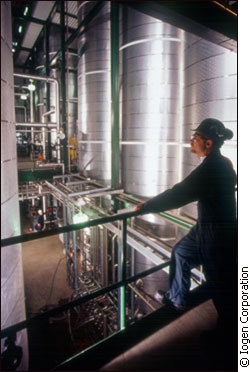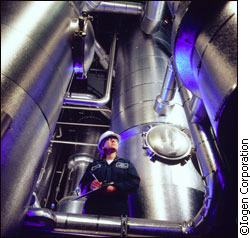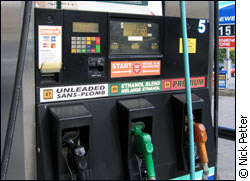
|
| On the south end of Ottawa lies a demonstration facility that makes ethanol in an unconventional way. It’s operated by Iogen Corporation, one of the nation’s biotechnology firms, whose slogan salutes ethanol as the clean-burning fuel of the future. There are high hopes that the fuel will help to curb both our gasoline cravings and greenhouse gas emissions (GHGs). Iogen’s research manager, Heather Pikor, sits down in the boardroom to discuss the innovative process and technology, which was over 20 years in the making. She’s brought in a number of small jars. The first contains what appears to be chopped up straw, similar to what you’d find on a barn floor. The contents of the very last, clear and almost water-like, is ethanol. " No one else uses enzymes to make ethanol" says Pikor. "There are no other companies making cellulose ethanol right now."
The privately owned company runs the world’s only demonstration plant that makes cellulose ethanol, using enzyme technology from agricultural waste like corn stover, barley, and cereal straws. Right now, they supply a handful of pumps in Ottawa and can process up to 20 to 30 tonnes of straw per week. Today, all vehicles can burn up to 10 per cent of ethanol mixed with unleaded gasoline (E10 blend) without any engine modification. Pikor says that the problem is fuel production. We have the cars and infrastructure to use ethanol, but there simply isn’t enough of it. Currently, Iogen is working to perfect their process before selling it worldwide. A move to commercializing its technology could mean more of this clean-burning fuel. The unconventional process Iogen’s novel process begins by adding leftover stover and straw into a pipe where it's chopped up as if in a blender. It goes through a high-temperature acidic cook where it’s stewed like a pot of vegetables. As the fibre becomes soft, all of its sugars are liberated. Enzymes, which are non-living proteins, are added to the mix to help in the chemical reactions. The enzymes occur naturally in a fungus called Trichoderma reesei, which Iogen grows in sterile fermenters. After its moves through a natural life cycle of about one week, it oozes enzymes that are pumped into the pipe. The enzymes break down the cooked fibre into the familiar liquid sugar, glucose. The chemical breakdown takes a few days. Eventually all that’s left is a mixture of half liquid glucose and another half, a solid-fibre called lignin. Iogen separates the two and adds yeast to the liquid sugar, which then ferments into alcohol. The alcohol is distilled to remove the water, leaving only the purest form of ethanol. It’s then sold to the pumps and used to make our engines run while releasing the least amount of GHG emissions.
The leftover lignin is a crucial by-product of the process. The fibre is fed into specially made turbines, designed to burn it. Instead of importing energy to fuel the machines (causing more GHGs), lignin fires up the process again. Iogen hopes to boost production by commercializing this enzyme technology. They have already received worldwide recognition because they’ve shown in the plant that it works. Still, Iogen is perfecting the process. Pikor says they hope to build the first plant by 2007 and each could cost upwards of $400 million. Leading car and oil companies like Volkswagen and Shell have shown interest, by announcing partnerships to build plants as far away as Germany. But Iogen may not be Canada’s only success story. Other companies are also trying to stir ethanol’s production pot. By offering a faster process, B.C.’s Syntec Biofuel, shows that there could be better methods out there. Syntec has also refined the conventional ethanol-making method in its five years of research. Lawrence Wong, the principal founder of the company, says its process is unique and different from Iogen’s. “Our process is shorter because it has fewer steps. We don’t have a fermentation stage, which can take days. We make ethanol thousands of times faster. We can produce it in a matter of seconds,” he says. Making ethanol from syngas Syntec is also not just restricted to making ethanol out of agricultural waste.The company can produce ethanol iusing gas from burning landfill, manure, sewage and wood. For example, Syntec’s process involves taking sewage and burning it in a chamber to make gas. It’s then purified through a filter to remove contaminants like carbon dioxide and nitrogen. The burning produces only five per cent waste. The ash and char can be used for other things, like agricultural fertilizer. Next, the gas is reformed into a mixture of hydrogen and carbon monoxide called syngas. After it’s compressed, special patented catalysts are added to turn it into ethanol. Syntec’s catalysts are multi-metal solids, which are the driving forces behind the process. The heat released in the method creates enough thermal energy to start it again like lignin does in Iogen’s plant. Wong says Syntec already has two patents on its catalysts. He predicts that the process will be ready in the next two or three years. " Nothing is new about the process except Syntec’s catalysts. It will be very easy to commercialize because syngas technology already exists, it’s been used for years and it works."
Wong is hopeful that Syntec’s technology will change the ethanol industry because of its low operating costs and quick production rates. With its innovative technology, production may never be an issue he says. Currently, Canada is a net importer of ethanol, says Claude Robert, a senior economist at the Office of Energy Efficiency at National Resources Canada. " We produce about 200 million litres of ethanol a year, but we import about 125 million litres from the United States," he says. Will new technologies pump ethanol production? The Canadian government is trying to encourage more production, Robert explains. Under its $100 million Ethanol Expansion Program of 2003, it has given financial assistance to build five conventional plants in Canada.
Robert says the government is also very interested in new technology like Iogen’s cellulosic process and have discussed with Iogen, new sites for a commercial plant in places like Saskatchewan. He cites the government’s interest in new development companies like Syntec too. It's important in the country’s quest for more ethanol production and use. Bill Cruickshank, manager of Biochemical Conversion at Natural Resources Canada says it takes awhile before new technology is commercialized to start production. The funding for Iogen’s research was spread out over a number of years, and right now government funding isn’t that high, he says. "Research and development funding for ethanol technology gets less than biodiesel and hydrogen," he says. "They get only about $750, 000 to $1 million a year which is low. It’s enough to support about five companies." Wong says Syntec gets about $200,000 a year. Pikor cites Canadian government support for Iogen’s research over many year including a $10 million loan to build the demonstration plant. Both companies also get money from private organizations and venture capitalists. Syntec’s methods are fast, but Cruickshank says it could take a long time before companies like it, can start building commercial plants like Iogen is going to do. "Iogen’s technology is advanced in terms of maturity because it started researching years ago," he says. "They are close to commercialization where other companies like Syntec may not be at that stage yet. The time and money it takes to reach that point and build a demonstration plant and test it out, takes five, 10, 15 and in Iogen’s case, 20 years." Whether or not these new technologies will really live up to their production promise isn't known, Cruickshank explains. He says new technology is always more expensive and so it’s harder for it to be competitive.
"It’s like when new DVD or CD players first came out it was $1000, now it’s half the price. The price of new technology eventually always goes down,” he says. "Cellulose ethanol or Syntec’s technology will be expensive in the beginning and so will its ethanol because it’s more costly to produce." Cruickshank explains that we may need some government financial assistance to build and operate new ethanol plants for it to be cost-competitive. "By the time the fifth or sixth plant is built, the price of the technology and operating it will go down. And if the price of oil stays high, then ethanol can compete. Companies will start buying more ethanol to blend and make their fuel." |
|
|



